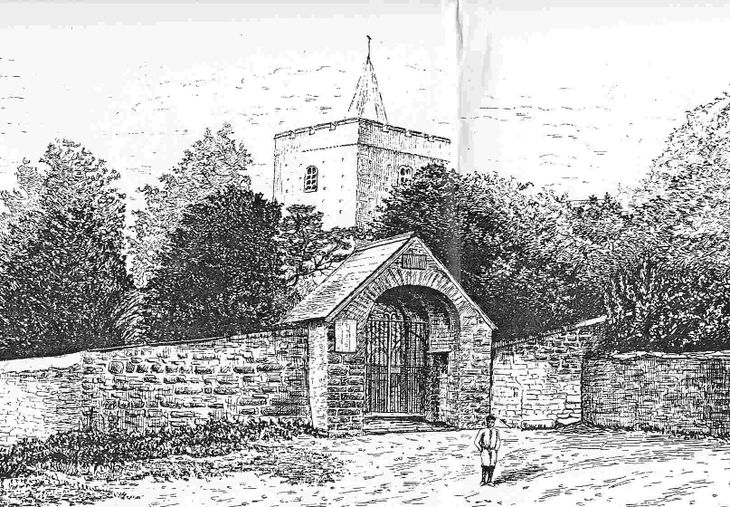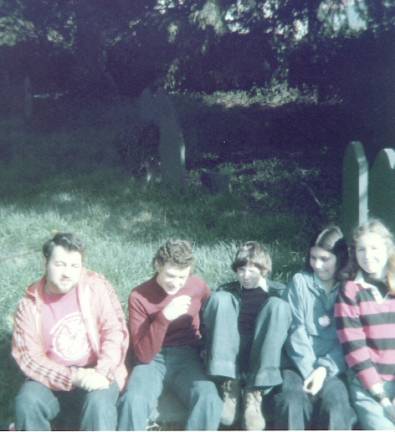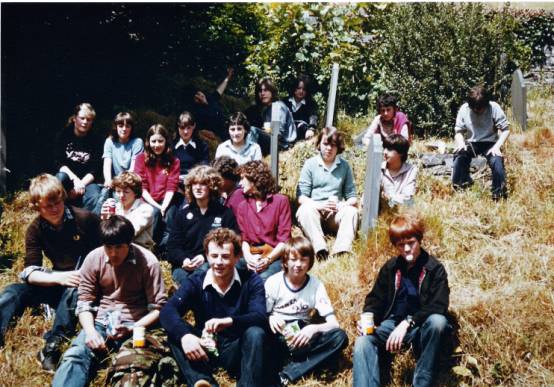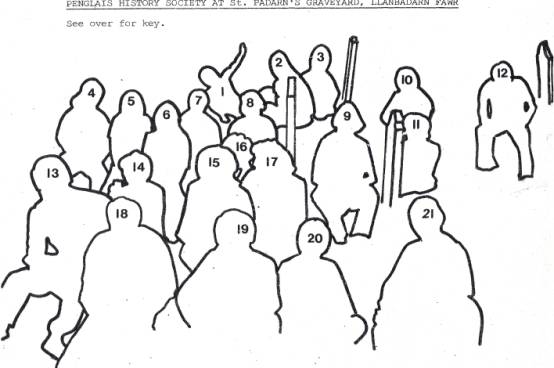LLANBADARN CHURCHYARD by A W GILBEY
The origins of this site began with the advert below in 1976:
PENGLAIS SCHOOL
Assistant teacher of History
The School believes in the value of knowledge of the local environment and the person appointed will be encouraged to develop pupil's interests in local history- through field work.
Cambrian News
16th of April 1976
This advert prompted a response from the Cambrian News reporter on local history - who later moved to Australia. He wrote
I am glad to hear from Dyfed Education Committee that Penglais School “believes in the value and knowledge of the local environment". Penglais School is now advertising for an assistant history teacher who will be encouraged to develop pupils' interest in local history through field work.
Will 0'Whispers. Cambrian News. 30th April 1976
Many years later – sometime in the 1980s – I finished the first draft of this book but then marriage, career, children and a thousand other things crept up. Now I have finally decided to put this book out in my name – not so much for my sake but more for the sake of those pupils who contributed to the work. I can only apologise that it has taken so long and would have taken longer had I not been alerted me to the spread of unauthorised copies of the draft work not only on paper but also, in one incredible case, on someone else's website without my permission.
The setting of this work is the churchyard at Llanbadarn Fawr and the following extract seems to sum up the atmosphere of the place:
The Churchyard of Llanbadarn, with its shady avenue of ash trees, and the few remaining
offsets of its venerable yew tree, is peculiarly fitted to awaken in the contemplative mind
those solemn feelings that arise on visiting the place of sepulture of those Who are gone before us to that bourne from whence no traveller returns, as it is full of the memorials of frail mortality and relics of elder time.
T .0. Morgan.
Aberystwyth Guide 1848
Llanbadarn Fawr is unique in the wide variety of educational institutions contained within the parish. It provides a system of education that can range from primary to post graduate tuition; from the happy bustle of Cwmpadarn Primary School to the academic tutelage of the University College of Wales. Between these institutions lies that most feared, and one suspect most loved, of educational institutions, the secondary school . From the introduction of comprehensive education into the area Penglais School became fully established on its present site in 1976; high on the Waun, it overlooks the town of Aberystwyth yet lies within the parish of Llanbadarn Fawr.
It was in the Autumn Term of 1976 that the Penglais School History Society was formed. The Society met on Mondays and the original members, in addition to the author, were: Hywel Jones, Jeremy Brown, D. Williams, David Clare, Rhys Griffiths, Doig Rudling, Andrew Slater, Peter Walkinghaw, Chris Whalley, Mark Spurgeon, Chris Jackson, Richard Ellis, Ceri Harries, Nigel Smith and Jessica Parker.
We were soon resolved to undertake a project based on an aspect of local history. The idea of a survey of the tombstones at Llanbadarn Fawr was put forward in reaction to a road widening scheme which at one time threatened to destroy a section of the Churchyard. It was originally our aim merely to record the section under threat but within a few weeks a more ambitious scheme had developed.
We approached the Vicar of the Parish, the Reverend Canon E. Ll. Edwards, with our projected scheme and he readily gave his permission for us to work in the Churchyard. He showed a great deal of interest in our plans and was able to offer us helpful advice on many occasions. He was also able to include a passage in the Parish Magazine of. October 1976 which illustrates the over ambitious nature of our plans at that stage:
The Churchyard.
A survey of Llanbadarn Fawr Churchyard is shortly to be made. This will be conducted by pupils of Penglais Comprehensive School under the supervision of Mr Albert Gilbey. This will be quite an undertaking and will involve recording the dimensions, boundaries and entrances of the Churchyard, footpaths, trees and bushes and their approximate age, together with the positions of the graves. Each memorial will be recorded, its type, shape, geology of the stone, the exact inscription, any decorations and symbols, name and origin of the mason or undertaker, and a note made of the general condition of both memorial and inscription. The results will be made available for future research. The possibilities are interesting and work could be done on family relationships, popularity of certain Christian names, life expectancy and many other topics of considerable interest to local historians.
The need for our survey is evident in that churchyards increasingly face decimation from the ravages of time and weather as well as overzealous clearance schemes. The churchyard of St Michael' s Church, Aberystwyth, was the subject of a clearance scheme that clearly demonstrates that artificial neatness is rarely aesthetically pleasing. The rough and tumble of a slightly overgrown churchyard, with its myriad ecological activities, seems infinitely preferable to the eczema of stones, standing stiffly to attention like so many guardsmen, that so often passes far development; in reality they represent a surrender to the cutting edge of the powered lawnmower.
The complexity of the recording task we had set ourselves was realised on our first day in the churchyard. Armed with ranging poles, tape measures, clipboards, pegs and string we arranged, on the ground, a couple of grids, each 10 square metres, as previously planned in the comfort of the classroom. We had planned a system of grids, each of ten metres, to cover the churchyard; the total number required was 116 grids. Rhys Griffiths had spent a few hours preparing the recording grid cards so that an accurate survey of the position of each stone within a particular grid could be recorded.
We did not appreciate, at the time, that such a scheme of work would prove too ambitious far the resources available to a school based local history society. We decided to organise the work along the scheme outlined in the pamphlet “How to record graveyards", written by Jeremy Jones and published by the Council for British Archaeology in 1976. The general aim of our project was to preserve, as fully as possible, the historical data contained an the memorials. This included the inscription, the size and condition of the stone, the geological nature of the stone, the technique of inscription and even the name of the mason.
The team that first day, February 23rd1977, (we had attempted a recording session the previous December but abandoned it due to icy rain), was composed of Christopher Jackson, Jennifer Jones, Rebecca Haynes, Mark Spurgeon, Jeremy Brown, Nigel Smith, Richard Tyler, Joanna Walters, Juliet Edwards, Jessica Koppel, Elaine Matthews and the author, Mr A W Gilbey. Arranging the grids took aver an hour and we had just begun sketching in the position of the stones while some were filling in the record cards when an elderly lady informed us that a wedding party was due at the Church within the hour. Hurriedly we dismantled the grids and departed.
It was obvious that it would be impossible to undertake the kind of detailed recording that we had hoped to achieve with a small group of school children who needed a fair amount of supervision. In addition we were restricted to a few brief hours of work on Saturday mornings and at the mercy of the weather. We therefore decided to abandon the grids and the recording cards and to concentrate our efforts on recording the memorial inscription and approximate location of each stone. In order to achieve this the entire yard was divided into a number of sections, each with some form of natural boundary. The position of each stone within a grid was sketched in using a tape measure and estimating distances in some cases. This method obviously lacked the accuracy of our original plan but: nevertheless, it was sufficiently accurate for our purposes and allowed us to produce tolerably accurate plans of each section. Each memorial stone was then allocated a number, preceded: by a letter to indicate its section: so A1, the first stone in Section A, was recorded by Chris Jackson and the survey had begun.
The system outlined above proved demanding for the pupils, mainly from the junior school, who carried out the survey but they proved themselves more than equal to the challenge. Their enthusiasm, their sense of duty and of humour filled the long hours spent at this survey in the period from December 1976 to August 1981 when the survey was completed. Without their efforts this book would never have been possible and it is to them that the author would like to express his deepest gratitude. Each and everyone of the pupils contributed in some way to the work and it would be fitting at this stage to record their names. The author was able to collect some autographs and these are given below. The names of the pupils involved in recording each of the sections are as follows and they cover the years 1977 to 1980: the work of recording the tombstones was finished by two friends and myself in 1981.
SECTION A
Jeremy Brown, Keith Davies, Shan Davies of Penweddig School, Juliet Edwards, Rebecca Haynes, Wyn Hughes, Christopher Jackson, Hywel Jones, Jennifer Jones, Jessica Koppel, Elaine Matthews, Simon Poole, Nigel Smith, Mark Spurgeon, Derek Thomas, Richard Tyler and Joanna Walters. In this photograph, taken in 1977 and only one of two photograph known to the author of work in progress are, left to right, A W Gilbey, Jeremy Brown, Hywel Jones, Jessica Koppel and Elaine Matthews.
SECTION B
Melanie Brown, Helen Cadman, Bethan Evans, Peter Hirst, Matthew Knight, Geraint Morgan, Steven Parham, Simon Poole, Sian King Thomas and Sara J. Williams.
SECTION C
Rachel Bennington. Helen Cadman. Andrew Davies. Peter Hirst, Huw Keri Jones, Geraint Morgan and Sara J. Williams.
SECTIONS D, E, F AND G
Melanie Brown , Nigel Davies, Sarah Devereux, Debbie Edwards, Bethan Evans, Tracie Evans, Ian Frost, Caroline Gill, Carol Griffiths, Dennis Griffiths, Dorothy Humphreys, Luigi Nardiello, Susan Nelson, George Nicholas, David Parker, Susan Phillips, Fred Rennie, David Richards, Teleri Roberts, Stephen Smith, Sian King Thomas, Roger Ward and Joanna Williams.
The photograph below shows most of the students name above who took part in 1980 in surveying the area behind the Church – their names are shown below the key:
Key to photograph.
1 . David Richards.
2. Roger Ward.
3. Theresa Prosser.
4. Teleri Roberts.
5. Bethan Evans.
6. Susan Phillips.
7 . Caroline Gill.
8. Susan Nelson.
9. Carol Griffiths.
10. Luigi Nardiello.
11. Joanna Williams.
12. lan Frost.
13. Dennis Griffiths.
14. Sian K Thomas.
15. Sarah Dereux.
16. Tracie Evans.
17. Melanie Brown.
18. David Parker.
19. Fred Rennie.
20. Nigel Davies.
21. Stephen Smith
SECTIONS H AND J
Mr A W Gilbey, Mr A R Emm and Mr D I Rudge.
I am grateful for the help of my two friends who between them prevented this section becoming the straw that broke my back – by August 1981, after over 50 months of work, the novelty of recording tombstones had well and truly lost what appeal it originally had.



